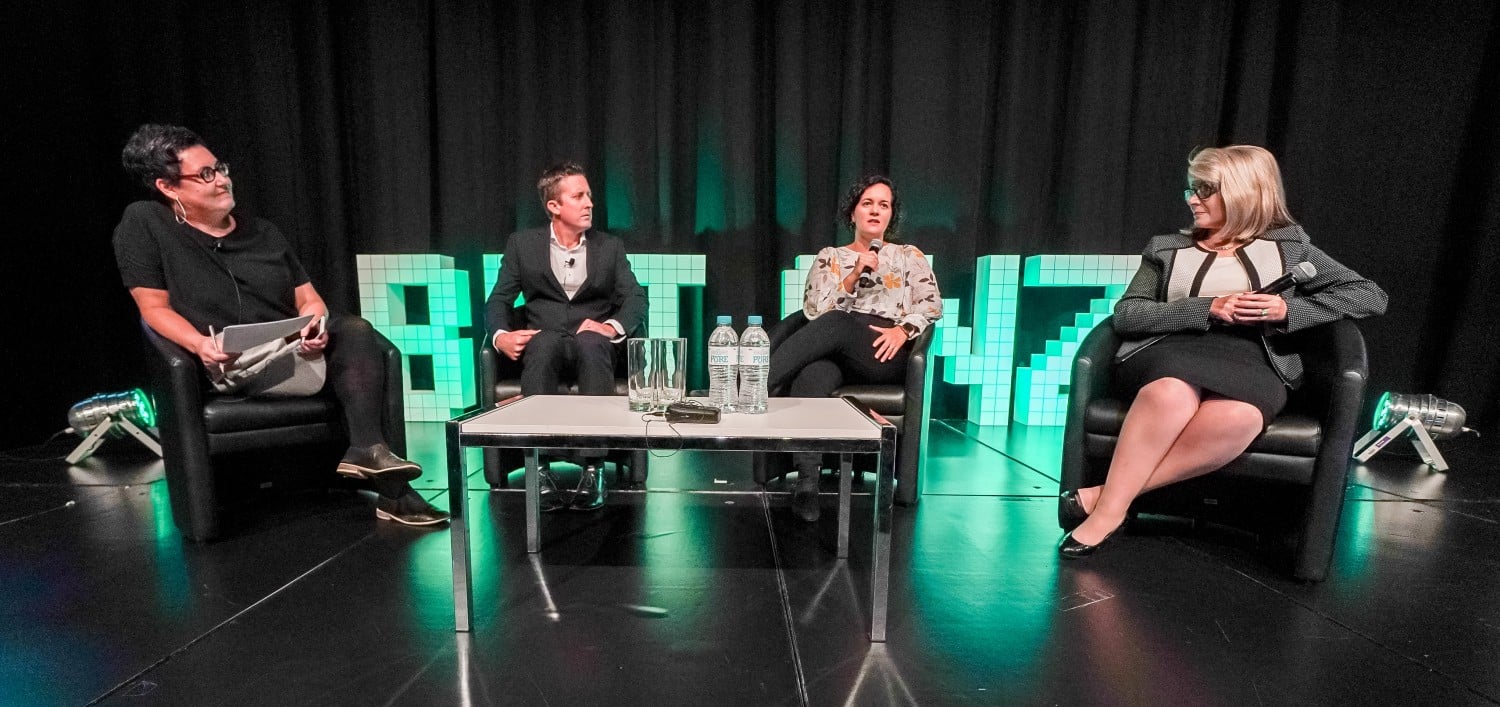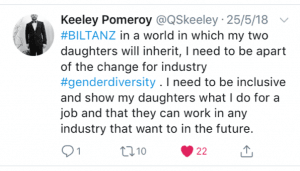The 2018 BILT ANZ conference featured a panel session on gender diversity to build awareness of its importance in the AEC and technology space. BILT committee member Ceilidh Higgins explores the issues.

Justine Clark chairs the “Challenging Our Industry – Gender Diversity in AEC and Technology” panel, with Todd Battley, Glenda Caldwell and Elizabeth Harper.
Different sectors within the construction industry have different issues to address, but one challenge that is relevant to all is gender balance. The construction industry is well known for being male-dominated, but the participation of women in the sphere of technology is even lower than overall participation rates in the wider industry. This is reflected in the attendance statistics for events like BILT ANZ 2018, where 84.5% of attendees were male.
BILT ANZ is Australia’s largest gathering of design and construction professionals focused on technology, with over 500 people attending this year’s event in Brisbane. It is a significant forum for discussion of key issues and challenges in the industry. This year, the BILT ANZ committee decided to provide a focus on the issue of gender diversity. We believe that gender diversity will help improve our industry and our community. The benefits of diversity are real and measurable, and those companies taking action are benefiting. These benefits include access to a wider talent pool, more flexibility for everyone and even higher financial performance for organisations with higher diversity measures. Diversity doesn’t just benefit companies but also individuals. Our community tends to be at the forefront of change in technology and many are passionate about doing better work and making their workplaces better through technology. We believe we have the opportunity to harness the spirit of change that already exists within our community and contribute to gender diversity in our industry, and particularly in the technology space.
Panel discussion
In order to promote awareness and generate discussion around this issue, we organised a panel session for one of our main plenary sessions for all 500 of our delegates. This session aimed to explore the questions:
- Why is gender diversity important?
- How does gender diversity benefit everyone?
- What can an individual do to help promote change?
We were lucky to have Justine Clark of Parlour as a moderator and an amazing line-up of diverse panellists who agreed to join us – Elizabeth Harper (CIO, GHD), Todd Battley (CEO, AECOM ANZ) and Glenda Caldwell (Senior Lecturer in Architecture, QUT). Each came from very different backgrounds in different parts of our industry, and brought a range of perspectives to this discussion.
As expected, our discussion covered the benefits of gender diversity in a business setting – “If you want to do an average job, do as you do now. If you want to do an excellent job, if you value excellence, you need the biggest group of people available to recruit from and to engage with to solve the problems of tomorrow” (Todd).
However, the discussion also covered the benefits to individuals, which are perhaps even more valuable, and not always so well understood by men as by women. Many men still think flexible working is a ‘women’s issue’. All of our panellists discussed the opportunities that a diverse, inclusive workplace offers to both men and women in flexible working, parental leave and other opportunities for fathers to become more involved in their children’s lives. Early in the session, Glenda posed the question: “How can we be creative in our use of technology to be more inclusive?” Technology has already been an enabler of flexible working. Are there other opportunities that technology will be able to offer businesses, individuals and even to our clients into the future?
Personally, I really liked Todd’s comment that “Delivery models are archaic and are failing us – the confrontational and high-risk nature of our business in Australia. We accept the aggressiveness and confrontational nature of our industry as being normal, but that doesn’t need to be the case. If we get a better balance, we could take some of that out… The way we do work might actually shift.” Perhaps I might go so far as to suggest we might actually improve many aspects of our industry that are holding us back from innovation.
What can you do as an individual to change things? While perhaps most of us aren’t senior executives or necessarily responsible for who we hire, many of us are managers, team leaders, role models for younger staff, or parents. In all of these roles, there are ways we can contribute.
All of our panel members spoke of modelling behaviours, whether it’s with your team at work or with your kids at home. Demonstrate by example – from running meetings to include all voices, to identifying role models for our younger staff or for our children so they realise that it is possible for both men and women to do different things. Empower others and work as a team. Give everyone opportunities. Elizabeth spoke of the importance of both mentoring and sponsorship for women, who may not be so inclined to put themselves forward as men would. Lead by example and take advantage of opportunities for flexible working and spending time with your families, and let people know you are doing it. These are all things that many of us can do in our everyday lives, regardless of your gender.
While we all realise we won’t be changing the industry overnight, this panel discussion has raised awareness among a male-dominated audience that gender diversity isn’t just a women’s issue. During the session, it was great to see a number of our delegates quoting and commenting on the panel via Twitter. One of the most popular tweets of the conference comes from this session:

Over the remaining two days of the conference, I personally had many conversations with delegates and speakers (both male and female) on the issues discussed, and overheard many more. We have made a great start at raising awareness and generating discussion – but how will this translate when people get home? Hopefully people have already taken on board some of the suggestions from the panel.
Next steps
For us as a committee, we are already starting to think further about how we can continue this discussion next year, and how we can contribute directly to support further change. Our panel has left us with our own challenge to increase the number of female delegates at next year’s event. Big topics for planning the 2019 event include how we might contribute to this, and what discussions and activities are going to be most important and impactful.
In the meantime, if you want to get involved, sign up for Women in BIM or if you are a woman in architecture looking to contribute via speaking, judging or teaching, add your name to Marion’s List. This is an initiative that all our delegates can contribute to – by our female delegates adding themselves and by any delegate sharing the initiative with colleagues. Also, consider getting involved with the National Association of Women in Construction, NAWIC.
This year, make it a point to submit your own abstract or encourage women in your team to submit abstracts for next year’s BILT. As always, feel free to get in touch with us with any comments, suggestions or questions via @BILTevent or secretary@rtcevents.com.
Ceilidh Higgins’ speciality is work – both the places we work and the way we work. Her day job is Senior Associate and Interior Design Leader at Custance Associates, where she specialises in workplace strategy and design, delivering workplace projects from as small as five people through to 1000 people or more. Her other passion is technology and she has been a well-known speaker at BILT for many years and in 2016 joined the organising committee. Outside of work, Ceilidh researches, writes and speculates on the future of work – both as a place and the processes of working within the AEC industry – and the impacts of technology upon both. You can find her writing at The Midnight Lunch.




















